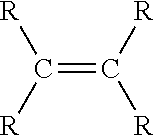Medical devices having homogeneous charge density and methods for making same
- Summary
- Abstract
- Description
- Claims
- Application Information
AI Technical Summary
Benefits of technology
Problems solved by technology
Method used
Image
Examples
preparation 1
[0148]N,N-dimethylacrylamide (DMA) and further purified via vacuum distillation. 5-acrylamidopentanoic acid (ACA2) was prepared according to Synthesis 3 The siloxy-functional benzyltrithiocarbonate, S-XG-1996-S′-hexyl-trithiocarbonate, was prepared according to Synthesis 1, above. Irgacure 819 was dissolved in D30 (10 mg / mL).
[0149]The polymerization solution was prepared by dissolving 1.1 g ACA2 in 3 mL of ethanol and 1.5 g DMA in an amber 20 mL glass vial. Next, 166 mg S-XG-1996-S′-hexyl-trithiocarbonate, and 1.51 mg (151 ul of stock solution) Irgacure-819 were added to the monomer and warmed / stirred to ensure homogeneity (CTA to initiator ratio=20). The amber vial containing the final polymerization solution was sealed with a rubber septum and purged for 20 minutes with N2 to remove O2 from the solution. Finally the sealed jar was placed in an N2 glove-box for storage.
[0150]The polymerization_solution was cured under an N2 atmosphere with 4 standard Phillips TL 20W / 03 RS bulbs at ...
preparation 2
[0153]N,N-dimethylacrylamide (DMA) was purified via vacuum distillation. 5-acrylamidopentanoic acid (ACA2) was prepared according to Synthesis 3. The siloxy-functional benzyltrithiocarbonate, S-XG-1996-S′-hexyl-trithiocarbonate, was prepared according to Synthesis 1. Irgacure 819, was obtained from Ciba Specialty Chemicals and dissolved in D30 (10 mg / mL).
[0154]The polymerization solution was prepared by dissolving 2.07 g ACA2 in 6 mL ethanol and 300 mg DMA in an amber 20 mL glass vial. Next, 58 mg S-XG-1996-S′-hexyl-trithiocarbonate, and 1.06 mg (106 ul of stock solution) Irgacure-819 were added to the monomer and warmed / stirred to ensure homogeneity (CTA to initiator ratio=20). The amber vial containing the final polymerization solution was sealed with a rubber septum and purged for 20 minutes with N2 to remove O2 from the solution. Finally the sealed vial was placed in an N2 glove-box for storage. The polymerization solution was cured and purified as described in Preparation 1. Th...
examples 1-12
[0159]Three senofilcon lenses were removed from their packages and transferred glass vials containing packing solution containing the non-reactive polysiloxane terminated hydrophilic polymer (“NRPTHP”) produced in Preparation 1 through 4 in the concentrations shown in Table 1. The lenses were re-packaged in the NRPTHP packing solution, autoclaved at 121° C. for 28 minutes and, after sterilization, were allowed to soak in the NRPTHP packing solution at ambient temperature for at least 24 hours. The contact angle, lysozyme uptake and PQ-1 uptake of the lenses were measured and are reported in Table 3. Untreated senofilcon lenses were also tested as a control.
TABLE 3[NRPTHP]% PQ1LysozymeEx#PrepDMA:ionic(ppm)CA°uptake(μg / lens)1170:30ACA25024 ± 57 ± 119 ± 32170:30ACA250028 ± 60 ± 044 ± 73170:30ACA2100029 ± 70 ± 551 ± 64280:20ACA25024 ± 139 ± 033 ± 55280:20ACA250032 ± 1824 ± 9 58 ± 76280:20ACA2100033 ± 1646 ± 7 65 ± 47380:20ACA25017 ± 47 ± 523 ± 48380:20ACA250022 ± 1213 ± 1 43 ± 59380:20A...
PUM
| Property | Measurement | Unit |
|---|---|---|
| Fraction | aaaaa | aaaaa |
| Fraction | aaaaa | aaaaa |
| Fraction | aaaaa | aaaaa |
Abstract
Description
Claims
Application Information
 Login to View More
Login to View More - R&D
- Intellectual Property
- Life Sciences
- Materials
- Tech Scout
- Unparalleled Data Quality
- Higher Quality Content
- 60% Fewer Hallucinations
Browse by: Latest US Patents, China's latest patents, Technical Efficacy Thesaurus, Application Domain, Technology Topic, Popular Technical Reports.
© 2025 PatSnap. All rights reserved.Legal|Privacy policy|Modern Slavery Act Transparency Statement|Sitemap|About US| Contact US: help@patsnap.com



